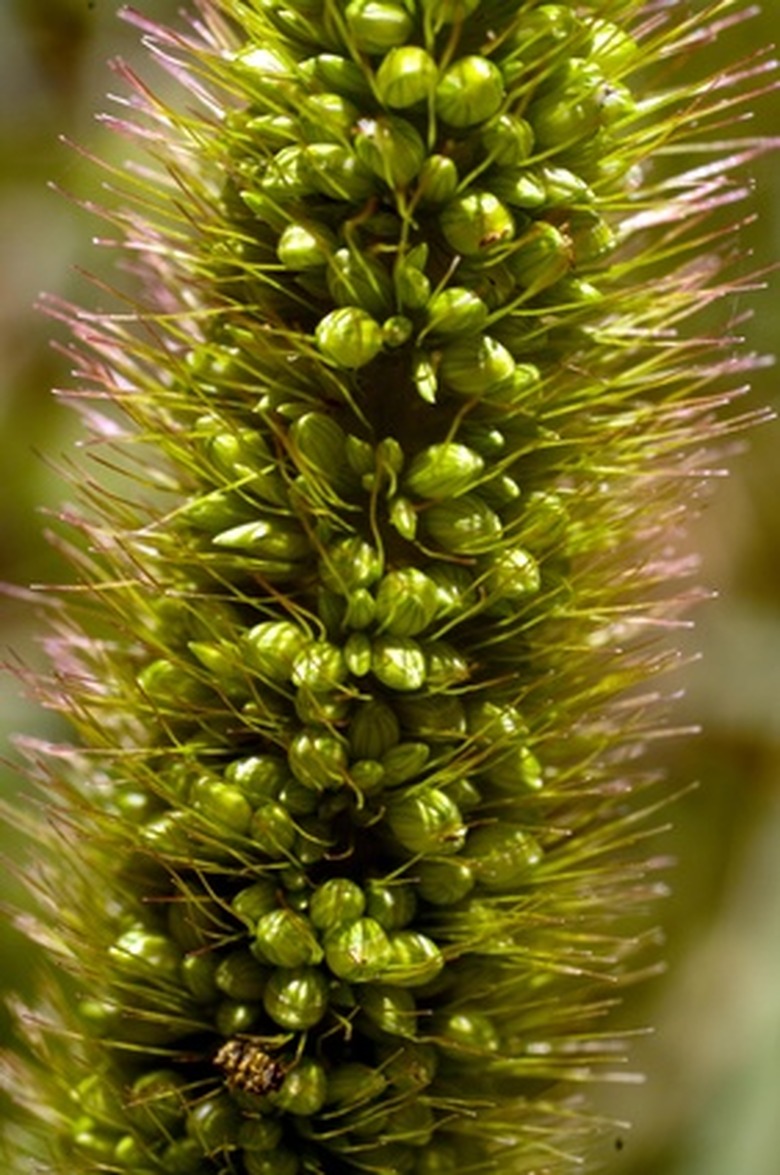Pearl Grass Vs. Carpet Grass
Pearl grass, or pearl millet (Pennisetum americanum), is a warm season annual agricultural grass grown as forage, silage and fresh-cut feed. Carpet grass (Axonopus affinis), also called flatgrass or Louisianagrass, thrives in warm, humid climates. A perennial grass with creeping stolons–horizontal shoots with rooting nodes–carpet grass performs well in poor soils. Its adaptability makes carpet grass a good choice for parks, roadsides and golf courses, according to Texas Cooperative Extension turfgrass specialist Richard L. Duble, Ph.D.
Carpet Grass Appearance
Carpet grass is a low-growing warm season grass with wide, rounded green leaf blades and narrow, long-branching seed stalks that resemble those of crabgrass, notes Duble. Its leaf sheaths a heavy coating of down. Its leaf tips often have a downy fringe. The seed stalk has two or three spikes with oblong seed spikelets of purple-tinged, light green. Carpet grass seed is golden brown.
- Pearl grass, or pearl millet (Pennisetum americanum), is a warm season annual agricultural grass grown as forage, silage and fresh-cut feed.
- Its adaptability makes carpet grass a good choice for parks, roadsides and golf courses, according to Texas Cooperative Extension turfgrass specialist Richard L. Duble, Ph.D.
- Carpet grass is a low-growing warm season grass with wide, rounded green leaf blades and narrow, long-branching seed stalks that resemble those of crabgrass, notes Duble.
Pearl Grass Appearnace
An upright grass sometimes standing more than 8 feet high, pearl grass has long, tooth-edged, pointed green leaves. Each plant produces a thick spike of fine, tan seeds small enough that a single pound of them contains 60,000.
Where Carpet Grass Grows
Carpet grass thrives in the sandy, wet soils of the southern United States. Its tolerance for shade and wet growing conditions give carpet grass a growing range wider than that of Bermuda grass. Abundant seed stalk production, however, makes it less desirable for lawns. Carpet grass lawns require regular rotary mowing to control the seed stalks.
Where Pearl Grass Grows
Pearl grass handles growing from southern Canada to the southern United States, where it's a common agricultural crop. It flourishes in acidic to slightly alkaline (pH of 5.5 to 7.5), well-drained soil. This is a disease, drought and humidity-resistant grass, according to the Farm Science Genetics web site.
- An upright grass sometimes standing more than 8 feet high, pearl grass has long, tooth-edged, pointed green leaves.
- Its tolerance for shade and wet growing conditions give carpet grass a growing range wider than that of Bermuda grass.
Planting Carpet Grass
Carpet grass grows best from seed planted after the final spring frost date and no later than Sept.15. It likes acidic (pH less than 7.0), infertile, loose soil. A quick carpet grass cover requires scattering 2 pounds of seed for each 1,000 square feet, advises Duble. Using a tractor with a grass drill and 15 to 20 pounds of seed per acre is the most efficient way to seed large areas. Kept moist for two weeks after seeding and given regular light irrigation after that, the grass should provide lawn density coverage in no more than 10 weeks. Grass fed with 1 pound of nitrogen for every 1,000 square feet of planting (and once per month thereafter) will help it spread more quickly.
Planting Pearl Grass
Pearl grass needs a soil planting temperature of at least 65 degrees Fahrenheit, notes Farm Science Genetics. Typical planting time is between May and July, although the soil temperatures may be suitable earlier than that in the deep South. Plant at a depth of 1/2 inch in moderately fertile soil. Amount of seed per acre is between 15 and 25 pounds. Row planting requires less seed than broadcasting the seed.
- Carpet grass grows best from seed planted after the final spring frost date and no later than Sept.15.
- Kept moist for two weeks after seeding and given regular light irrigation after that, the grass should provide lawn density coverage in no more than 10 weeks.
